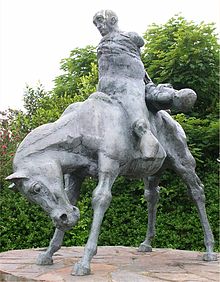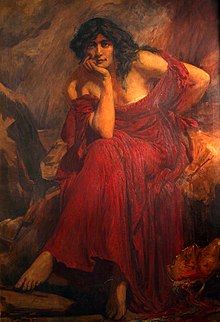


The Mabinogion (Welsh pronunciation: [mabɪˈnɔɡjɔn] ) are the earliest Welsh prose stories, and belong to the Matter of Britain. The stories were compiled in Middle Welsh in the 12th–13th centuries from earlier oral traditions. There are two main source manuscripts, created c. 1350–1410, as well as a few earlier fragments. The title covers a collection of eleven prose stories of widely different types, offering drama, philosophy, romance, tragedy, fantasy and humour, and created by various narrators over time. There is a classic hero quest, "Culhwch and Olwen"; a historic legend in "Lludd and Llefelys", complete with glimpses of a far off age; and other tales portray a very different King Arthur from the later popular versions. The highly sophisticated complexity of the Four Branches of the Mabinogi defies categorisation. The stories are so diverse that it has been argued that they are not even a true collection.[1]
Scholars from the 18th century to the 1970s predominantly viewed the tales as fragmentary pre-Christian Celtic mythology,[2] or in terms of international folklore.[3] There are certainly components of pre-Christian Celtic mythology and folklore; however, since the 1970s,[4] an understanding of the integrity of the tales has developed, with investigation of their plot structures, characterisation, and language styles. They are now seen as a sophisticated narrative tradition, both oral and written, with ancestral construction from oral storytelling,[5][6] and overlay from Anglo-French influences.[7]
The first modern publications were English translations by William Owen Pughe of several tales in journals in 1795, 1821, and 1829.[8] However it was Lady Charlotte Guest in 1838–45 who first published the full collection,[9] bilingually in Welsh and English. She is often assumed to be responsible for the name "Mabinogion", but this was already in standard use in the 18th century.[10] Indeed, as early as 1632 the lexicographer John Davies quotes a sentence from Math fab Mathonwy with the notation "Mabin" in his Antiquae linguae Britannicae ... dictionarium duplex, article "Hob". The later Guest translation of 1877 in one volume has been widely influential and remains actively read today.[11] The most recent translation is a compact version by Sioned Davies.[12] John Bollard has published a series of volumes with his own translation, with copious photography of the sites in the stories.[13] The tales continue to inspire new fiction,[14] dramatic retellings,[15] visual artwork, and research.[16]
- ^ John K. Bollard. "Mabinogi and Mabinogion - The Mabinogi". The Legend and Landscape of Wales Series
- ^ Notably Matthew Arnold; William J. Gruffydd.
- ^ Kenneth Hurlstone Jackson. 1961. The International Popular Tale and the Early Welsh Tradition. The Gregynog Lectures. Cardiff: CUP.
- ^ Bollard 1974; Gantz 1978; Ford 1981.
- ^ Sioned Davies. 1998. "Written Text as Performance: The Implications for Middle Welsh Prose Narratives", in: Literacy in Medieval Celtic Societies, 133–148
- ^ Sioned Davies. 2005. "'He Was the Best Teller of Tales in the World': Performing Medieval Welsh Narrative", in: Performing Medieval Narrative, 15–26. Cambridge: Brewer.
- ^ Lady Charlotte Guest. The Mabinogion. A Facsimile Reproduction of the Complete 1877 Edition, Academy Press Limited Edition 1978, Chicago, Ill. p. xiii.
- ^ 1. William Owen Pughe. 1795. "The Mabinogion, or Juvenile Amusements, Being Ancient Welsh Romances". Cambrian Register, 177–187.
2. William Owen Pughe. 1821. "The Tale of Pwyll". Cambro-Briton Journal 2 (18): 271–275.
3. William Owen Pughe. 1829. "The Mabinogi: Or, the Romance of Math Ab Mathonwy". The Cambrian Quarterly Magazine and Celtic Repository 1: 170–179. - ^ Guest, Lady Charlotte (2002). "The Mabinogion" (PDF). aoda.org. Archived from the original (PDF) on 2016-03-04.
- ^ "Myths and legends – The Mabinogion". www.bbc.co.uk. BBC Wales – History –Themes. Retrieved 2017-08-01.
- ^ Available online since 2004. Charlotte Guest. 2004. "The Mabinogion". Gutenberg. http://onlinebooks.library.upenn.edu/webbin/gutbook/lookup?num=5160.
- ^ Sioned Davies. 2007. The Mabinogion. Oxford: Oxford University Press.
- ^ 1. John Kenneth Bollard. 2006. Legend and Landscape of Wales: The Mabinogi. Llandysul, Wales: Gomer Press.
2. John Kenneth Bollard. 2007. Companion Tales to The Mabinogi. Llandysul, Wales: Gomer Press.
3. John Kenneth Bollard. 2010. Tales of Arthur: Legend and Landscape of Wales. Llandysul, Wales: Gomer Press. Photography by Anthony Griffiths. - ^ For example, the 2009–2014 series of books commissioned by Welsh independent publisher Seren Books; but the earliest reinterpretations were by Evangeline Walton starting in 1936.
- ^ e.g. Robin Williams; Daniel Morden.
- ^ "BBC – Wales History – The Mabinogion". BBC. Retrieved 2008-07-11.